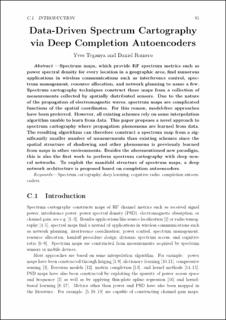| dc.contributor.author | Teganya, Yves | |
| dc.contributor.author | Romero, Daniel | |
| dc.date.accessioned | 2020-12-02T12:46:03Z | |
| dc.date.available | 2020-12-02T12:46:03Z | |
| dc.date.created | 2020-09-16T21:11:40Z | |
| dc.date.issued | 2020 | |
| dc.identifier.citation | Teganya, Y. & Romero, D. (2020). Data-Driven Spectrum Cartography via Deep Completion Autoencoders. IEEE International Conference on Communications. doi: | en_US |
| dc.identifier.isbn | 978-1-7281-5089-5 | |
| dc.identifier.issn | 1938-1883 | |
| dc.identifier.uri | https://hdl.handle.net/11250/2711487 | |
| dc.description | Accepted manuscript. | en_US |
| dc.description | © 2020 IEEE. Personal use of this material is permitted. Permission from IEEE must be obtained for all other uses, in any current or future media, including reprinting/republishing this material for advertising or promotional purposes, creating new collective works, for resale or redistribution to servers or lists, or reuse of any copyrighted component of this work in other works. | |
| dc.description.abstract | Spectrum maps, which provide RF spectrum metrics such as power spectral density for every location in a geographic area, find numerous applications in wireless communications such as interference control, spectrum management, resource allocation, and network planning to name a few. Spectrum cartography techniques construct these maps from a collection of measurements collected by spatially distributed sensors. Due to the nature of the propagation of electromagnetic waves, spectrum maps are complicated functions of the spatial coordinates. For this reason, model-free approaches have been preferred. However, all existing schemes rely on some interpolation algorithm unable to learn from data. This paper proposes a novel approach to spectrum cartography where propagation phenomena are learned from data. The resulting algorithms can therefore construct a spectrum map from a significantly smaller number of measurements than existing schemes since the spatial structure of shadowing and other phenomena is previously learned from maps in other environments. Besides the aforementioned new paradigm, this is also the first work to perform spectrum cartography with deep neural networks. To exploit the manifold structure of spectrum maps, a deep network architecture is proposed based on completion autoencoders. | en_US |
| dc.language.iso | eng | en_US |
| dc.publisher | IEEE | en_US |
| dc.title | Data-Driven Spectrum Cartography via Deep Completion Autoencoders | en_US |
| dc.type | Journal article | en_US |
| dc.type | Peer reviewed | en_US |
| dc.description.version | acceptedVersion | en_US |
| dc.rights.holder | © 2020 IEEE | en_US |
| dc.subject.nsi | VDP::Teknologi: 500::Informasjons- og kommunikasjonsteknologi: 550 | en_US |
| dc.source.pagenumber | 7 | en_US |
| dc.source.journal | IEEE International Conference on Communications | en_US |
| dc.identifier.doi | 10.1109/ICC40277.2020.9149400 | |
| dc.identifier.cristin | 1830631 | |
| dc.relation.project | Norges forskningsråd: INDNOR | en_US |
| dc.relation.project | Norges forskningsråd: 250910 | en_US |
| dc.source.articlenumber | 19853969 | en_US |
| cristin.qualitycode | 1 | |
